113th Engineer Battalion (United States)
The 113th Engineer Battalion is an "Echelons Above Brigade" (EAB) Army Engineer Battalion of the Indiana National Guard, currently attached to the 219th Engineer Brigade, 81st Troop Command. Their missions include construction and combat effects in support of higher operational Army echelons. Units of the 113th are found in Gary, Valparaiso, Franklin, and Edinburgh/Camp Atterbury, Indiana.
| 113th Engineer Battalion | |
|---|---|
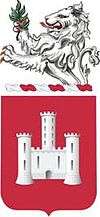 113th Engineer Bn coat of arms | |
| Active | 1917-1919 1923-present |
| Country | |
| Branch | Indiana Army National Guard |
| Type | Echelons Above Brigade |
| Role | Mobility, Counter-Mobility, Survivability, General Engineering |
| Size | Battalion |
| Nickname(s) | "Ironmen" |
| Motto(s) | "Service and Fidelity" |
| Engagements | New Guinea Southern Philippines Luzon Iraq Afghanistan |
| Commanders | |
| Current commander | LTC John C. Roark |
| Insignia | |
| Distinctive unit insignia | 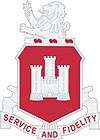 |
| Callsign | IRONMAN |
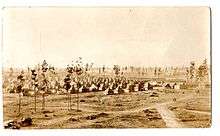
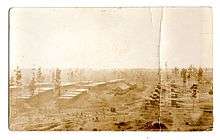
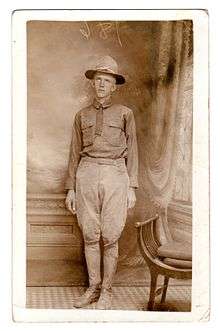
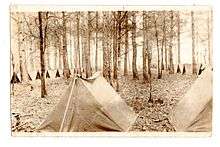
World War I
On 6 April 1917, the United States entered World War I on the side of Great Britain, France, and Russia. Prior to 1917, the United States Army was smaller than 13 of the nations already involved in the War, with around 121,000 Active Duty Soldiers and around 181,000 National Guardsmen. However, with the U.S.'s entry into the War, the Selective Service Act of 1917 was put into effect. 4 million men were drafted into service, and the Army expanded significantly. New units were formed, and existing units were moved around to meet the Army's growing numbers. Among these new units was the 38th Infantry Division, activated as a National Guard Division in August 1917. Guard units from Indiana, Kentucky, and West Virginia began movement to Camp Shelby, Mississippi, reorganizing themselves into the 75th Infantry Brigade (for Kentucky and West Virginia units) and the 76th Infantry Brigade (for Indiana units - it is the precursor to the modern-day 76th Indiana IBCT). On 16 September 1917, Company M (sans Officers) of the 3rd Regiment, Kentucky Infantry was designated the 113th Engineer Battalion and assigned to the 38th Infantry Division.[1] Training began in October 1917, and continued for the next ten months. The 113th arrived in France with the rest of the 38th ID in September-October 1918, during the height of the German "Peace Offensives." While most of the 38th ID was stripped down to serve as replacements for units already in combat, the 113th Engineers assisted in constructing bases and infrastructure for the American Expeditionary Forces, of which nearly 10,000 Soldiers were still arriving every day. From Brest, France, the 113th and other engineering units built nearly 1,000 miles of standard-gauge tracks, and over 100,000 miles of telephone and telegraph lines. After Armistice Day, 11 November 1918, the 113th moved with the 38th ID to the city of Konz in the Allied-occupied Rhineland as part of the Army of the Occupation of Germany. They remained there until they finally returned to the United States in Spring of 1919.
Interwar Period (1919-41)
After returning home, the 38th entered an inactive status while the United States rapidly demobilized and returned to a peacetime footing. However, the experiences of the War convinced the War Department and Congress to retain a reserve structure to improve America's readiness in future wars. A series of Amendments to the National Defense Act of 1916 included adding the National Guard to the Regular Army's structure when in federal service. The names, numbers, flags, and records of the divisions that served in World War I, including the 38th ID, were to be preserved for future use. The 113th was transitioned back to active status in 1921. By November 1921 the Indiana National Guard had approximately 4,000 actively drilling National Guardsmen. By March 1923, the 38th ID Headquarters was federally recognized and established in Indianapolis. Its commanding officer, Major General Robert H. Tyndall, embodied the citizen-soldier concept in the future of America's Army, further improving the readiness of Indiana's National Guard and organizing the American Legion. It was at this time that the 76th Infantry Brigade, the 139th and 150th Field Artillery Regiment, and the 113th Engineer Regiment were allotted solely to Indiana.
In the coming decades, the 113th Engineers served with the U.S. Army Corps of Engineers during the Ohio River flood of 1937, assisting in evacuation efforts and building more than seventy storage reservoirs to reduce Ohio River flood heights, a project that would continue into the early 1940s. The 113th also served with other National Guard units in Wisconsin during the 1940 Armistice Day Blizzard, assisting in rescue efforts for survivors trapped in 27 inches of snow, as well as rebuilding the telegraph/telephone poles and buildings that had been damaged in the 50-80mph winds.
As France fell to Nazi Germany, and tensions continued to grow with Imperial Japan, Congress passed the Selective Training and Service Act of 1940 in October 1940, requiring all men between the ages of 21 and 45 to register for the draft. In preparation for the War that many were sure was coming, the 38th ID was once again ordered into federal service. The 113th Engineers were mobilized on 17 January 1941, and began training with the rest of the 38th ID. Eleven months later, Imperial Japan bombed Pearl Harbor, and the United States entered World War II.
World War II
The 38th ID continued to train for three more years, before finally embarking to Hawaii on 3 January 1944, arriving on 17 January. There the 113th Engineers and 38th ID received further training, and improved the defensive capabilities of Oahu. In July 1944, the 113th Engineers embarked with the 38th ID to New Guinea. From July to November 1944, they conducted final combat rehearsals, while also searching out any Japanese Soldiers that were bypassed in the Western New Guinea campaign. With rehearsals complete, the 38th ID sailed for Leyte, landing in December 1944. The 113th Engineers brought with them 400 tons of assault and pioneering equipment, 140 tons of 30-day engineer supplies, and a complete "Bailey Bridge" unit weighing over 89 tons. For two months the 113th Engineers assisted in the defense of Leyte, including defending Buri, Bayug, and San Pablo airstrips from Japanese paratroopers until 4 January 1945. The 38th ID then sailed for Luzon, the largest island of the Philippines and the site of the Bataan Death March three years earlier. The 113th Engineers landed in the Zambales Province without any opposition on 29 January. For the next two days, they assisted in securing and building defensive structures at the San Marcelino airstrip and the port facilities at Olongapo, as well as the Grande Island in Subic Bay after a separate amphibious landing. While the 38th ID's 151st Infantry Regiment secured Subic Bay, the 38th ID's 152nd Infantry Regiment and 113th Engineers were given the mission to drive eastward along an irregular and unimproved Route 7. A section of Route 7 that the 152nd and 113th were travelling on went through the rugged Zambales mountains at the northern base of the Bataan peninsula - a path Americans called 'Zig-Zag Pass.' It was there that Japanese Colonel Nagayoshi Sanenobu decided to make his stand with his 39th Infantry Regiment. The Japanese had dug foxholes, trench, and tunnels throughout the mountains, and relied on the thick vegetation to cover their positions. On the morning of 1 February, the 152nd and the 113th ran into a Japanese strongpoint at 'Horseshoe Bend,' the first major Zig-Zag Pass obstacle. Two days of heavy fighting followed, resulting in high casualties and stopping all eastward progress. The nearby 34th Regiment Combat Team was ordered to assist the 152nd and 113th, but after six days of suffering heavy casualties they were forced to disengage. The 151st linked up with the 152nd and 113th the next day to continue the battle, but fighting remained fierce for three more days. However, with the combined forces with the 151st, 152nd, and the 113th, the Japanese began to give more and more ground until they were finally overrun on 8 February. Afterwards, the 152nd and 113th continued eastwards, finally linking up with XIV Corps on 14 February. Through 8 days of fighting, it was estimated that the 151st, 152nd, and 113th killed about 2,400 of the 2,800 Japanese defenders in Zig-Zag Pass. For the next seven days, the 113th pushed along the route of the March of Death to Bagac. The Bataan Peninsula was secured on 21 February - the 38th ID's rapid drive through Route 7 and across the peninsula was critical to General MacArthur's campaign plan to retake the Philippines.
Over the next few months, the 113th would assist the 38th ID in the final liberation of the Philippines from Imperial Japan, securing Corregidor on 24 February and Caballo Island on 27 March. In April, the 38th ID advanced directly into the Zambales mountains, pushing out the last of the dug-in Japanese defenders. The 113th Engineers were instrumental in surrounding the retreating Japanese and cutting off their withdrawal routes. After the Zambales were cleared, the 38th moved east of Manila, where they continued fighting into May. By 30 June, all effective Japanese positions had been broken. The 113th Engineers spent the rest of the war assisting in hunting down bypassed Japanese Soldiers, as well as improving defensive capabilities of American and Philippine positions. This concluded with Japan's unconditional surrender on 14 August, bringing an end to the 38th ID's unbroken stretch of 198 consecutive days in combat. Combined, elements of the 38th ID killed 26,469 enemy combatants and took 1,411 prisoners. As news of the war's end spread to the remaining Japanese defenders, that number soon swelled to 13,000 prisoners by October.
Post World War and Cold War
The 113th Engineers were alerted on 15 September 1945 that they were going to return to the United States and demobilize, and were finally relieved on 5 October. They sailed to Camp Anza, California. Final demobilization and deactivation was completed on 9 November 1945. Subordinate units of the 38th ID were organized and reconstituted, swelled by the large numbers of World War II veterans. The 113th Engineers were reorganized on 6 October 1946, and were federally recognized with the rest of the 38th ID on 5 March 1947. Division headquarters were once again in Indianapolis, and Annual Training began being held at Camp Atterbury in 1948.
During the Cold War, the 113th Engineers served in the Strategic Reserve to support the Active Army in the event of a full-scale war with the Soviet Union. In 1965, the 38th ID was designated part of the Selected Reserve Force, which put its units, including the 113th, in a higher priority for better equipment and greater funding to ensure readiness was maintained. However, the 113th Engineers did not participate in the Vietnam War. In fact, with the exception of Company D (Ranger), 151st Infantry Regiment, the entire 38th ID was not activated for federal service for the entire length of the Vietnam War. Company D (Ranger), 151st INF went on to become one of the most highly decorated Army units to serve in the conflict. Instead, the 113th continued to serve the homefront, being called up for State Active Duty during the Perfect Circle Strike of 1955, as well as the Palm Sunday tornado outbreak of April 1965.
Post 9/11 and Global War on Terrorism
The 113th Engineer Battalion was deployed to northern Iraq in support of Operation Iraqi Freedom in 2005. They conducted Soldier Readiness Processing at Camp Atterbury in late 2004, and arrived in-country between mid-December 2004 to early-January 2005. They operated in Nineveh Governorate, Iraq for the entirety of their 12-month deployment, engaging with enemy forces in combat several times. At the time, the 113th was equipped with the M-113 APC, and later with M-1114 Up-Armored Humvees. The 113th was home by the end of 2005 with no combat deaths.[2]
In March 2012, the Battalion was awarded the Valorous Unit Award for their performance in Operation Founding Fathers during Iraq's 2005 elections.[3]
In 2011, the 713th Engineer Company, 113th, was alerted they were deploying to Kandahar Province, Afghanistan. They mobilized for training in October, and arrived in-country in November 2011. Their mission for the 10-1/2 month deployment was to patrol roads and clear roadside IEDs around Forward Operating Base (FOB) Frontenace in support of Operation Enduring Freedom.
In two incidents, the 713th Engineer Company lost six Soldiers during this deployment. The first was on 6 January 2012, when the third vehicle in an eight-vehicle convoy hit a roadside IED. SSG Jonathan Metzger, SPC Robert Tauteris Jr., SPC Brian Leonhardt (posthumously promoted to SGT), and SPC Christopher Patterson were killed in the explosion, with a fifth Soldier, PFC Douglas Rachowicz suffering multiple injuries as a result of the blast. Six months later on 17 July 2012, two more 713th Soldiers, SPC Sergio Perez and SPC Nicholas Taylor, were killed in action during a mounted route clearance attack. Within the Indiana National Guard, the six 713th Engineer Company Soldiers who were killed during the 2012 deployment are remembered as 'The Sapper Six.'
Currently, the 113th Engineer Battalion is deployed in Kuwait. They were mobilized in September 2019, arrived in-country in December, and are expected to return in mid-2020.
Headquarters and Structure
For most of its history, the 113th Engineer Battalion, Indiana Army National Guard, was a subordinate unit of the Engineer Regiment and Brigade, 38th Infantry Division. After the deactivation of the Engineer Regiment and Brigade, the 113th Engineer Battalion was designated a separate Heavy Combat Battalion, while remaining assigned to the 38th ID. In 2003, the battalion was transferred to the Military Department of Indiana's 81st Troop Command, where it remained until 2015.[4] In October 2015, the 113th Engineer Battalion was realigned under the newly designated 219th Engineer Brigade, formerly the 219th Battlefield Surveillance Brigade. It remains under the command of the 219th Engineer Brigade to this day.
Units as of 2016: Headquarters and Headquarters Company (HHC) and Forward Support Company (FSC) are both located in Gary, IN. The 713th Engineer Company (SAPPER) is located in Valparaiso, IN. The 1313th Engineer Company (Horizontal Construction) and 1413th Engineer Company (Vertical Construction) are located in Franklin, IN. The 719th Engineer Detachment (EN DET) (Firefighter Headquarters), 819th EN DET (Firefighter Truck), 919th EN DET (Firefighter Truck), 1019th EN DET (Firefighter Truck), 1319th EN DET (Well Drilling Headquarters), and the 1331st EN DET (Well Drilling Team), are all located in Edinburgh, IN/Camp Atterbury.
Distinctive unit insignia
- Description
A silver metal and enamel device 1 5/32 inches (2.94 cm) in height, consisting of a shield, crest and motto.
- Symbolism
The silver triple-towered castle, taken from the arms of St. Dizier in France, denotes the battalion's World War I service. The shield is red and the charge is white, the colors of the U.S. Army Corps of Engineers. The crest is that of the Indiana Army National Guard.
- Background
The distinctive unit insignia was originally approved on 26 May 1928 for the 113th Engineer Regiment, Indiana National Guard, consisting of the shield and motto. The design was changed to add the crest on 5 June 1936. It was re-designated for the 113th Engineer Combat Battalion on 19 November 1943. The insignia was once again re-designated for the 113th Engineer Battalion, Indiana Army National Guard on 23 September 1963.
Coat of arms
- Blazon
- Shield- Gules, a triple-towered castle (from the arms of St. Dizier, France) Argent.
- Crest- For the regiments and separate battalions of the Indiana Army National Guard: On a wreath of the colors Argent and Gules, a demi-lion rampant Argent, holding a laurel branch Vert in his right paw.
- Motto SERVICE AND FIDELITY.
- Symbolism
- Shield- The silver triple-towered castle, taken from the arms of St. Dizier in France, denotes the organization's World War I service. The shield is red and the charge is white, the colors of the U.S. Army Corps of Engineers.
- Crest-The crest is that of the Indiana Army National Guard.
- Background- The coat of arms was originally approved for the 113th Engineer Regiment, Indiana National Guard on 26 May 1928. It was re-designated for the 113th Engineer Combat Battalion on 19 November 1943. The insignia was re-designated for the 113th Engineer Battalion, Indiana Army National Guard on 23 September 1963.
See also
- Coats of arms of U.S. Engineer Battalions
Notes
- Annual Reports of the War Department, Volume 1: Report of the Chief of the Militia Bureau. United States War Department. (Jan 1, 1919) p. 1189, Table 29. https://play.google.com/store/books/details?id=yWFGAQAAMAAJ&rdid=book-yWFGAQAAMAAJ&rdot=1
- "Stryker Brigade News: Welcome home for the 113th". Archived from the original on 29 April 2009. Retrieved 2009-03-19.
- "Archived copy". Archived from the original on 2 December 2013. Retrieved 13 September 2012.CS1 maint: archived copy as title (link)
- http://www.globalsecurity.org/military/agency/army/113eng.htm